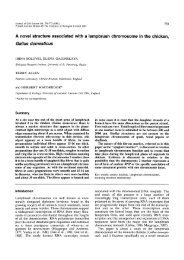Sutton Common Updated project design - University of Exeter
Sutton Common Updated project design - University of Exeter
Sutton Common Updated project design - University of Exeter
Create successful ePaper yourself
Turn your PDF publications into a flip-book with our unique Google optimized e-Paper software.
2.8 Palynology<br />
The samples assessed as part <strong>of</strong> the borehole survey were not found to be afflicted by problems<br />
<strong>of</strong> preservation and as such, the availability <strong>of</strong> both ‘on site’ and ‘<strong>of</strong>f site’ contexts for pollen<br />
analysis allow the academic research objectives to be addressed. Additional questions arising<br />
from the assessments may also be identified. Specifically, the pollen data from Trenches 3, 4<br />
and 5 indicates that alder woodland characterised the environment <strong>of</strong> <strong>Sutton</strong> <strong>Common</strong> for the<br />
period following the cutting <strong>of</strong> the ditches with apparently little evidence for heavily disturbed<br />
ruderal contexts.<br />
Analysis <strong>of</strong> ‘on site’ and ‘<strong>of</strong>f site’ sequences will allow the former record to be placed within<br />
the longer term context <strong>of</strong> vegetational change at the site provided by the latter. It will also<br />
permit the investigation as to what extent the apparently low level <strong>of</strong> impact identified from<br />
the ditch fills is typical <strong>of</strong> the wider context <strong>of</strong> the site’s environment both in the period preceding<br />
and that following monument construction.<br />
Establishing the nature and extent <strong>of</strong> human impact on the environment over the last 2000<br />
years has previously been identified as a priority for east England, since most organic deposits<br />
suitable for palaeoenvironmental reconstruction have been heavily impacted upon by drainage,<br />
ploughing and peat cutting (e.g. Van de Noort & Ellis, 1999, 2000, 2001). The data that is<br />
available tends to be plagued by problems <strong>of</strong> absolute dating and its derivation from sampling<br />
sites marginal to the ‘cultural’ landscape (e.g. Kirby & Gearey 2001). The only substantial<br />
long term palaeoenvironmental records currently available for this region have been derived<br />
from the raised mires <strong>of</strong> Thorne and Hatfield Moors (Smith 2001, Gearey in prep.) which tend<br />
to provide a ‘spatially smoothed’ record <strong>of</strong> regional vegetational change.<br />
At <strong>Sutton</strong> <strong>Common</strong>, the presence <strong>of</strong> deposits in proximity to an excavated archaeological site<br />
allows questions regarding the precise nature <strong>of</strong> environmental changes associated with human<br />
activity during the later prehistoric period to be addressed. It has been hypothesised that by<br />
the later Iron Age, the landscape <strong>of</strong> east Yorkshire was open and organised, but to date the<br />
opportunity to reconstruct individual components <strong>of</strong> this landscape mosaic and the precise<br />
palynological signal <strong>of</strong> the construction <strong>of</strong> a specific monument has not been forthcoming. In<br />
terms <strong>of</strong> national research priorities, the character <strong>of</strong> lowland cultural landscapes are generally<br />
poorly understood, resulting in an over-reliance on data from upland areas which tend to be<br />
richer in suitable deposits, to extrapolate to lowland contexts. Palaeoenvironmental data from<br />
<strong>Sutton</strong> <strong>Common</strong> should begin to redress this balance.<br />
The value <strong>of</strong> analysing ‘<strong>of</strong>f site’ deposits such as are preserved in the palaeochannels is that<br />
these have the potential to produce long term sequences <strong>of</strong> environmental change, which will<br />
provide a context for the record from the ‘on site’ deposits discussed above. Furthermore, it is<br />
only through the analysis <strong>of</strong> the ‘<strong>of</strong>f site’ deposits that certain <strong>of</strong> the main academic questions<br />
can be addressed.<br />
It is thus recommended that detailed palynological analyses are carried out on a sequence<br />
which includes the maximum temporal depth in the deepest depth <strong>of</strong> sediment and includes<br />
as much <strong>of</strong> the later Holocene as is available. The suggested sampling location is that at<br />
which the palynological assessment suggests a record <strong>of</strong> vegetational development from the<br />
early through to the mid-Holocene and possibly including the later prehistoric period is<br />
preserved in c.2.5 m <strong>of</strong> sediment (Lillie & Sch<strong>of</strong>ield 2002: 22). This will provide both a useful<br />
long term picture <strong>of</strong> vegetational change and also a record against which the ‘on-site’<br />
information derived from the ditch and buried soil can be compared. It is recommended that<br />
this sequence will be sampled at 0.08m intervals and 500TLP for all sequences (except for<br />
the buried soil which is only 0.10m thick -interval <strong>of</strong> 0.02m for this). More closely-spaced<br />
analyses will be undertaken where abrupt changes occur. In addition, it is recommended that<br />
critical horizons <strong>of</strong> this sequence are dated by radiocarbon following consultation with the<br />
17
















